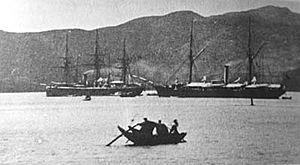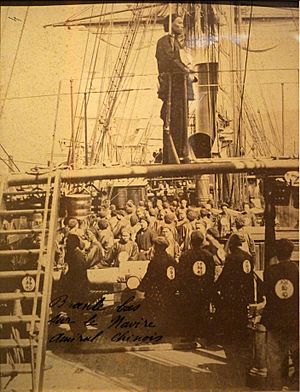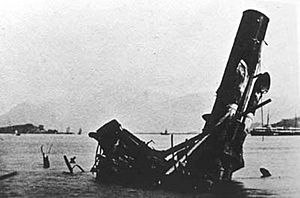Chinese corvette Yangwu facts for kids

Yangwu (pictured left) with the Chinese gunboat Fuxing at anchor, the night before the Battle of Fuzhou.
|
|
Quick facts for kids History |
|
|---|---|
| Name | Yangwu (揚武) |
| Namesake | Yangwu |
| Builder | Foochow Arsenal |
| Launched | April 23, 1872 |
| Fate | Sunk August 23, 1884 |
| General characteristics | |
| Type | Corvette |
| Displacement | 1,393 long tons (1,415 t) |
| Length | 190 feet 2 inches (57.96 m) |
| Beam | 36 feet (11 m) |
| Draught | 16 feet 5 inches (5.00 m) |
| Installed power | |
| Propulsion | Steam engine |
| Speed | 13 knots (24 km/h; 15 mph) |
| Complement | 270 |
| Armament |
|
Yangwu (Chinese: 揚武; pinyin: Yangwu; Wade–Giles: Yang-wu or Yang Woo) was a wooden corvette, a type of small warship, built for the Imperial Chinese Navy. She was built in 1872 at the Foochow Arsenal, a major shipyard in China. Yangwu was the biggest ship made there between 1868 and 1875.
Early in her life, Yangwu was used as a training ship to teach new sailors and officers. She was even commanded by English captains for a time. Later, she played a key role in the Battle of Fuzhou in 1884. This battle was the start of the Sino-French War. Yangwu was the flagship (main ship) of the Fujian Fleet. During the battle, she was hit by a special weapon called a spar torpedo. This caused a huge explosion, and most of her crew were lost. Enemy fire then quickly sank her.
Contents
What Was the Yangwu Like?
Yangwu was a special ship built at the Foochow Arsenal. She was 190 feet 2 inches (57.96 m) long and 36 feet (11 m) wide. Her average draft (how deep she sat in the water) was 16 feet 65 inches (6.53 m). The ship weighed about 1,393 long tons (1,415 t).
How Did Yangwu Move?
The ship was powered by a 250-horsepower (190 kW) steam engine. This engine was built by a company called John Inglis and Company. It used four boilers to create steam. Yangwu also had a funnel that could be pulled back. Her engines allowed her to travel at a speed of 13 knots (24 km/h; 15 mph).
What Weapons Did Yangwu Have?
Yangwu was well-armed for her time. She had a battery of eight 5-inch (130 mm) 70-pounder guns. Four of these were on each side of the ship. Two more were placed at the front and stern (back) as chase guns. These guns were made by a British company called Armstrong's.
She also carried a larger 6.5-inch (170 mm) 150-pounder gun in the middle of the ship. Two 24-pounder long guns completed her weapon collection. The ship stored its gunpowder in two special rooms called gunpowder magazines, one at the front and one at the back.
Building and Early Life of Yangwu
Yangwu was a wooden corvette. She was built at the Foochow Navy Yard and was launched on April 23, 1872. She was the seventh ship built as part of a big shipbuilding plan at the Foochow Arsenal. Building Yangwu cost 254,000 taels, which was about 353,000 silver dollars.
She was the largest warship built there between 1868 and 1875. The shipyard was managed by a Chinese official named Shen Baozhen. However, Western experts, mostly from France, advised the Chinese on how to build the ships. They suggested building wooden ships, even though other countries were already making stronger ironclad ships. Later, some Chinese officials blamed the French for giving them outdated designs.
Yangwu as a Training Ship
After her launch in 1872, Yangwu became a training vessel from 1875. She sailed in the South China Sea and even made a trip to Japan. Yangwu had a classroom on board where Chinese midshipmen (young officers in training) and other officers learned.
In June 1876, a report said there were 30 sailors being trained on the ship. At that time, an Englishman named Captain Tracey commanded Yangwu. He was later replaced by another Englishman, Captain Luxmore. Besides these two officers, the rest of the crew were Chinese.
Journeys to Australia and Manila
In the summer of 1876, Yangwu visited the Australian colonies. Later that year, in December, Chinese ambassadors to Great Britain visited Yangwu in Singapore. After this visit, the ship sailed to Manila.
In February 1877, an accident happened when the crew was preparing a gun salute in Manila harbor. A gun went off too soon, throwing a crewman into the water and killing him. He was later buried in the city. Yangwu was a big sight for the people of Manila, especially the Chinese residents. Many sailed out in small boats to greet her, and others watched from a hill overlooking the bay.
Rising Tensions with France
On June 23, 1884, tensions between the French Empire and Imperial China were growing. Yangwu was part of the Chinese fleet at Chefoo (now Yantai). They met with a French group of ships, including two cruisers and a sloop. The French showed how powerful their cruisers were. These ships were nearly two and a half times bigger than Yangwu, which was the largest Chinese ship there. The French showed they could hit targets over 4,000 metres (4,400 yd) away. After this meeting, Yangwu went to the naval yard at Foochow (now Fuzhou). The other Chinese ships went to the port of Tianjin.
The Battle of Fuzhou
On August 9, 1884, French naval forces attacked and captured Keelung on the island of Formosa (now Taiwan). This was because China was involved in the Tonkin Campaign. Soon after, the French Navy's Far East Squadron, led by Rear Admiral Amédée Courbet, sailed up the Min River. Their goal was to attack the arsenal at Foochow. As they sailed, China officially declared war on France, starting the Sino-French War.
Yangwu was the lead ship of the Fujian Fleet defending Foochow. She was commanded by Captain Chang Cheng. The fleet also included three sloops, many gunboats, transport ships, and war junks. British and American navy ships in the port anchored far away from where the battle was expected. The ships waited for several days. The French were waiting for a powerful ironclad ship called Triomphante to join them. They planned to attack just before 2 PM on August 23. Two torpedo boats were ordered to attack Yangwu and the gunboat Fusheng first.
Just before 2 PM on August 23, the battle began. A Chinese gunboat fired at a French gunboat. This was the signal for the small torpedo boats to move forward. About 27 seconds later, a huge explosion happened on Yangwu. A torpedo boat had hit her with its spar torpedo just below the water line in the middle of the ship. The explosion was so big that only fifteen crew members survived. Some people even claimed that bodies were thrown over 1 mile (1.6 km) away onto rooftops, but this was likely an exaggeration. Eyewitnesses also doubted the number of survivors, suggesting that only those who jumped into the river before the explosion could have lived.
A report after the battle included an interview with a survivor named Mr. Yung. He said he was at the back of Yangwu when the explosion happened. He explained that the ship had fired back at a French cruiser before being hit. Orders were given to keep firing even after the explosion. However, French guns made this very difficult. Despite this, Yangwu managed to damage the other torpedo boat. Captain Chang Cheng gave Yung a life jacket and told him to jump first, saying he would follow. As Yung swam away, he saw the Captain helping an engineer who was badly burned. Soon after, the front gunpowder magazine exploded, destroying the rest of the ship.
The damaged Yangwu drifted as the French ships continued to fire at her. She caught fire and then sank. The French won the battle at Foochow very clearly. They lost only six or 12 people, with 27 missing. The Chinese losses were much higher, with 521 killed, 150 wounded, and many missing. The French continued to bombard the arsenal for two days. Then, they sailed back down the river, destroying any forts they found along the way.
Images for kids






